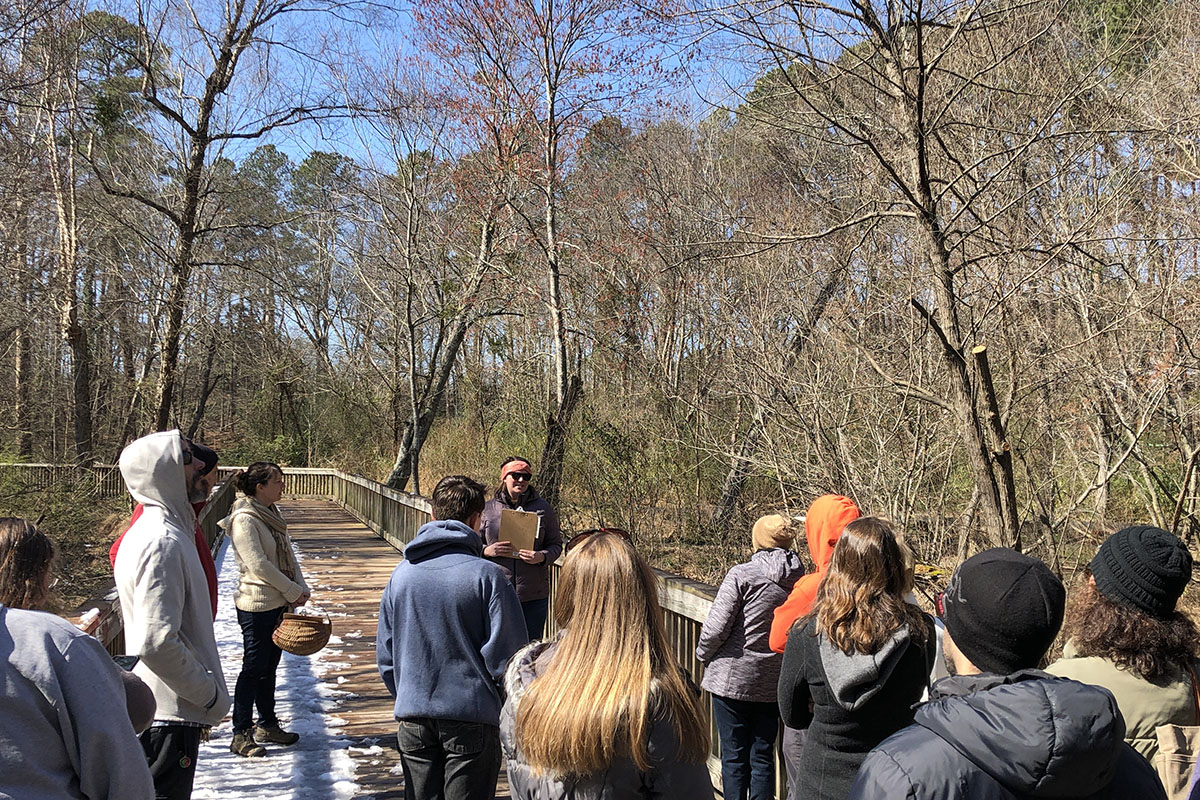
Piedmont Picnic Project instructors take participants on Wild Walks to find edible wild plants in the urban and suburban environment. (Josephine McRobbie)
Finding fresh local foods in late winter and early spring can be a challenge, but a closer look at our backyards and walking paths reveals edible wild weeds everywhere. They can be pickled, added to smoothies, pesto, and tea, and used as toppings for pizza, pasta, and salads. "All of these spring greens are little nutritional powerhouses right now, because they are storing up so many nutrients right before they go to flower," says 'homesteader-light' Amanda Matson. Along with public historian Elizabeth Weichel, she runs the food skills organization Piedmont Picnic Project. The group's classes cover topics like mixology, gardening, and fermentation, and are grounded in local history. Today's event is a wild history foraging walk. As we walk towards a greenway, Elizabeth will share how major snowfalls impacted the state capital as it developed into an agricultural powerhouse, while Amanda will show us how to identify edible plants.
We start off with safety and etiquette. The first rule is "Know The Plant", a skill one can develop with plant ID books, guides like Amanda or Elizabeth, or even phone apps or YouTube videos. "Don't eat anything that you're unsure what it is," says Amanda. "Make sure that you've positively identified it." She recommends getting permission from home and property owners to pick plants, and to be mindful of how one forages them. "We never want to over-harvest plants from a particular area," she says. "There are some plants that are actually at risk or endangered because people have over-harvested them."
We take off across a busy intersection, walking past a local high school and stopping to examine the grass by the parking lot. Amanda says common environmental hazards can include poison ivy, fire ants, pollutants near industrial zones, and railroad tracks that are heavily sprayed with herbicides. This area looks promising. "If the grass is a polyculture like we're seeing along here, there are a lot of different weeds growing," says Amanda. "It's a pretty good sign that they're not spraying, or at least haven't sprayed anytime recently.".
We spy our first plant, dock. This variety has fat leaves that curl like fried bacon. "The best tasting (leaves) are going to be the youngest leaves," says Amanda "When you cook dock, it tastes kind of like a slightly lemony spinach." She says the more mature leaves can be used to make a variation on a grape leaf wrap. We pick a few tall hollow tubes of field garlic, also known as onion grass. Amanda notes that it has a strong garlicky smell and makes for a good pesto. The bulbs, she says, "are really cute in a little wild martini, if you're into that kind of thing."
As we head into the mouth of a greenway, we see a clump of edible weeds including hoary bittercress, which grows in little pom-pom-like bursts. In the mustard family, it has a peppery, arugula-like taste. Another green, dandelion, is bitter, and Amanda and Elizabeth describe a Southern spring ritual of cooking the leaves with pork fat and vinegar to soften their flavor. By the end of the half-mile walk, we've also found chickweed, wild geranium, purple dead nettle, and henbit.
We head back to Well Fed Garden, where we prepare pizzas with some special pantry ingredients from the Piedmont Picnic Project - wild greens pesto, hen of the woods mushrooms, pickled pine tips, and muscadine marinara sauce. As a final activity, we try our hand at foraging pizza toppings from the weeds in the garden beds. The field garlic is especially plentiful.
Hear the story on this episode of Earth Eats.












